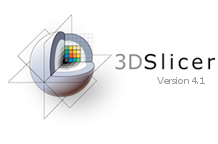Documentation/Nightly/HowTo
|
For the latest Slicer documentation, visit the read-the-docs. |
| 3D Slicer | |
|---|---|
 | |
| Description | |
| Research platform for the analysis and visualization of medical images, including image guided therapy. | |
| Free and extensible open source package. | |
| Multi-platform | Linux, MacOSX, Windows |
| Version | Nightly |
| License | Contribution and Software License Agreement |
Overview
This document aims at describing the principle and guidelines to consider when writing Slicer user documentation.
The documentation framework has been designed keep keeping in mind the following principles:
- Keep documentation at the same place as the source code to make it possible to keep the documentation always in sync with the software implementation.
- Allow anyone to make changes or propose changes to the documentation.
- Follow common documentation conventions (formats, rendering tools, and services)
Module page
- module-header and module-footer templates should be respectively used at the top and the bottom of the page.
- modulename should be used instead of writing in plain text the name of the module.
- Base your work on either Documentation/Nightly/Modules/YOURMODULENAME or an existing module documentation.
- For CLI modules, the SVNREVISION revision number is reported on this page. The module description and the information for developers would be automatically extracted from the corresponding XML description.
- See this page to define the revision number. The revision number associated to a module is used to extract module information from the source code directly.
Documentation for a CLI module
The main idea is to re-use the documentation of the CLI parameters in the wiki. When a CLI is added into Slicer, please execute the following steps to create the module online documentation.
- Create a CLI in Slicer4/Modules/CLI
- Add your module in Documentation/Nightly/ModulesMetadata. Adding a module consists of adding a module name+revision pair alphabetically in the list. The revision number must correspond to the most up to date revision number of your module.
- Copy the content of the template module and paste it in a page you created with the name of your module: Documentation/Nightly/Modules/YOURMODULENAME.
- Edit the wiki code to replace the generic information with the module specific information. You can upload screenshots and tutorials.
Documentation for a loadable module
Creating online documentation for loadable modules is similar to CLI modules. The difference is that loadable modules don't have parameter descriptions, it must be added separately.
- In Slicer4, if it doesn't exist yet
- create a Documentation subdirectory in your module directory (e.g. Slicer4/Modules/Loadable/Transforms/Documentation).
- Copy and rename the YourModuleName.{xml,dox} files from an existing module documentation.
- Add description for each section of your module (YourModuleName.xml) applying the following pattern:
<parameters>
<label>Section1 header</label>
<parameter>
<label>Parameter1 name</label>
<description><![CDATA[Parameter1 description]]></description>
</parameter>
</parameters>
<parameters>
<label>Section2 header</label>
<parameter>
<label>Parameter2 name</label>
<description><![CDATA[Parameter2 description]]></description>
</parameter>
<parameter>
<label>Parameter3 name</label>
<description><![CDATA[Parameter3 description]]></description>
</parameter>
...
Documentation for a scripted module
The trick used in loadable module documentation is not supported yet for scripted modules. Documentation must be written directly in the created module wiki page.
Extension page
- Create an extension page
- extension-footer template should be at the bottom of the page. Except for page doing a REDIRECT.
- If the extension bundles exactly one module, use this template
- If the extension bundles more than one module, use this template.
- Add an extension entry in Documentation/Nightly/Extensions#Extension_Categories
- The extension should now be listed on Documentation/Nightly.
- Create a regular wiki page for each module of the extension using the template page. The URLs of the extension modules are the same than the built-in modules.
Remarks
Actively maintained and developed extension
- If the extension is actively developed and maintained so that the code of the nightly extension is the same as the extension associated with a specific slicer release (i.e 4.10), a different approach could be considered.
Extension bundles ONE module
- In addition to create the following pages:
Documentation/Nightly/Extensions/YOURMODULENAME Documentation/4.10/Extensions/YOURMODULENAME Documentation/Nightly/Modules/YOURMODULENAME Documentation/4.10/Modules/YOURMODULENAME
- ... and setup the following redirect:
Documentation/Nightly/Extensions/YOURMODULENAME -> Documentation/Nightly/Modules/YOURMODULENAME
Documentation/4.10/Modules/YOURMODULENAME -> Documentation/Nightly/Modules/YOURMODULENAME
Documentation/4.10/Extensions/YOURMODULENAME -> Documentation/Nightly/Modules/YOURMODULENAME # Since double redirect are not supported. Version specific extension page redirects to Nightly module page.
- The only page that would be updated would be the Nightly one:
Documentation/Nightly/Modules/YOURMODULENAME
Extension bundles N modules
In addition to create the following pages:
Documentation/Nightly/Modules/YOURMODULENAME_0 Documentation/Nightly/Modules/YOURMODULENAME_1 [...] Documentation/Nightly/Modules/YOURMODULENAME_N Documentation/Nightly/Extensions/YOUREXTENSIONNAME Documentation/4.10/Modules/YOURMODULENAME_0 Documentation/4.10/Modules/YOURMODULENAME_1 [...] Documentation/4.10/Modules/YOURMODULENAME_N Documentation/4.10/Extensions/YOUREXTENSIONNAME
- ... and setup the following redirect:
Documentation/4.10/Modules/YOURMODULENAME_0 -> Documentation/Nightly/Modules/YOURMODULENAME_0 Documentation/4.10/Modules/YOURMODULENAME_1 -> Documentation/Nightly/Modules/YOURMODULENAME_1 [...] Documentation/4.10/Modules/YOURMODULENAME_N -> Documentation/Nightly/Modules/YOURMODULENAME_N
Documentation/4.10/Extensions/YOUREXTENSIONNAME -> Documentation/Nightly/Extensions/YOUREXTENSIONNAME
- The only page(s) that would be updated would be the Nightly ones:
Documentation/Nightly/Modules/YOURMODULENAME_0 Documentation/Nightly/Modules/YOURMODULENAME_1 [...] Documentation/Nightly/Modules/YOURMODULENAME_N Documentation/Nightly/Extensions/YOUREXTENSIONNAME
Case where a version specific documentation page diverges from the Nightly one
- If for some reason the documentation associated with the version specific extension is going to diverge from the Nightly one. Before modifying the Nightly page, *MAKE SURE* to create the associated version-ed page(s) by copying the content of the Nighty module page(s) into their own page(s).
Miscellaneous
- High resolution logos are in the Logo Gallery
- There is a python helper script for SEM compliant tools that can save a significant amount of transcription time: Slicer/Utilities/Scripts/SEMToMediaWiki.py
- To use it run "python Slicer/Utilities/Scripts/SEMToMediaWiki.py -x XMLFILE.xml -o OUTPUT.txt" and the mediawiki content will be in OUTPUT.txt